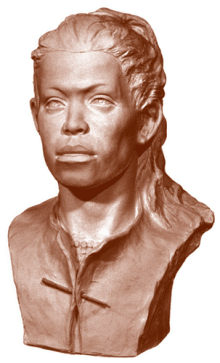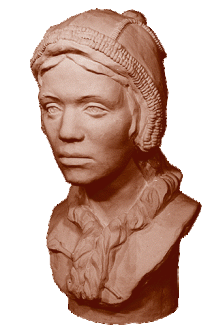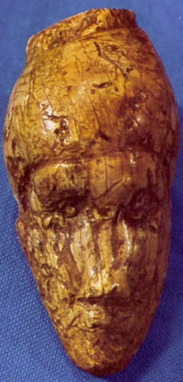The Sunghir site is a paleolithic site in Russia about 190km East of Moscow, dated to approximately 25,000 years BP.


The adults (female and male) from Sunghir. Note the very strongly developed jawlines. The lady has a somewhat Asian look to her cheekbones. The man was sixty years old when he died, ancient by paleolithic standards.


The boy (13) and a girl (8) from the site. More detailed information about them is found here at this excellent site, right down to the DNA investigation of the remains ans isotope analysis of bones (which as always shows a very high proportion of meat in the diet).
The Burials
The Sunghir site is well known because of the style of the burials. The deceased were buried wearing very heavily beaded clothing.

The burial of the male. Counted in the grave were 2,936 ivory beads. He is also wearing armlets of ivory, that showed traces of red and black paint. An artists reconstruction of his outfit below.

Artist: Illustration © Libor Balák
And the double burial of the children, buried head to head. It’s thought they were siblings. They were aged 8 and 13, and they were even more heavily beaded than the man: the boy had 4,903 beads, the girl 5,274 beads.

Artist: Illustration © Libor Balák
This is one of the sites where it’s thouight the people were possibly wearing woven cloth as well as hides. The children were also buried with decorated ivory spears. A small horse pendant can be seen next to the boys shoulder.

These people seemed heavily into beaded decoration, and it’s estimated that each bead, using a production line technique, took more than an hour to complete. I can’t help wondering if possibly beads could have been used as a form of currency. A predictable number of hours labour went into them, this could have made their use as a currency possible.
A great place for more artists impressions of the Sunghir people and more detailed information on the artifacts and bead making process, Dons Maps. there is also another good visual page here.
In interesting snippet on how they lived..
Palaeozoologic analysis of the osteologic material from the Sunghir site revealed clear hunting specialisation – hunt for fur-bearing animals. Apparently, cold climate made it necessary to intensify this type of hunt to obtain materials for clothing. The reconstructed cloth makes it possible to see how adequate the fur was used and how ergologic the cloth was. Proceeding from the results of the biological indicators, it can be supposed that adult and subadult (preadolescent) males of the group participated in hunts. The Sunghirians’ clothes ornamented with thousands of beads show how labour-consuming this work was. This type of locomotive activity is revealed in girl’s skeleton. It allows us to suppose that the work was done by females. Besides this, carrying of the weights on the head was the work of the female part of the community also, because nor juvenile, neither man possessed this indicator.
Fire pits, tens of fireplaces, agglomerations of bones, the places of bone and flint processing show high human activity at the site. Nevertheless, the fact that only surface dwellings existed across the site can be considered as the evidence of its seasonal use. Placed on the surface or slightly deepened dwellings of Anosov-Mesin type with the socle of large mammoth bones or more complex constructions of Kostjonky-Avdeevo type reveals long usage duration, and consequently a settled life of the groups. Opposite to them, the Sunghir inhabitants were mobile, ready to move in one or another direction, following the needs of night’s lodging, preys’ processing and obtaining necessary tools. The fact is notable, that the settlement was located on height eminence, far from natural streams. Probably there were springs, serving as sources of drinking water. The tools with the traces of their usage in gathering were found at the site.
Apparently, the Sunghirian group utterly used the patterns of the landscape and was actively adapted to the climatic factors of the environment.

















